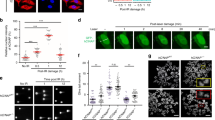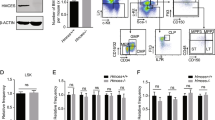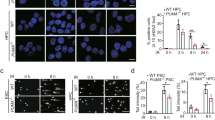Abstract
Hematopoietic stem and progenitor cells (HSPC), that is, the cell population giving rise not only to all mature hematopoietic lineages but also the presumed target for leukemic transformation, can transmit (adverse) genetic events, such as are acquired from chemotherapy or ionizing radiation. Data on the repair of DNA double-strand-breaks (DSB) and its accuracy in HSPC are scarce, in part contradictory, and mostly obtained in murine models. We explored the activity, quality and molecular components of DSB repair in human HSPC as compared with mature peripheral blood lymphocytes (PBL). To consider chemotherapy/radiation-induced compensatory proliferation, we established cycling HSPC cultures. Comparison of pathway-specific repair activities using reporter systems revealed that HSPC were severely compromised in non-homologous end joining and homologous recombination but not microhomology-mediated end joining. We observed a more pronounced radiation-induced accumulation of nuclear 53BP1 in HSPC relative to PBL, despite evidence for comparable DSB formation from cytogenetic analysis and γH2AX signal quantification, supporting differential pathway usage. Functional screening excluded a major influence of phosphatidylinositol-3-OH-kinase (ATM/ATR/DNA-PK)- and p53-signaling as well as chromatin remodeling. We identified diminished NF-κB signaling as the molecular component underlying the observed differences between HSPC and PBL, limiting the expression of DSB repair genes and bearing the risk of an inaccurate repair.
This is a preview of subscription content, access via your institution
Access options
Subscribe to this journal
Receive 12 print issues and online access
$259.00 per year
only $21.58 per issue
Buy this article
- Purchase on Springer Link
- Instant access to full article PDF
Prices may be subject to local taxes which are calculated during checkout






Similar content being viewed by others
References
Newhauser WD, Durante M . Assessing the risk of second malignancies after modern radiotherapy. Nat Rev Cancer 2011; 11: 438–448.
Zhang L, Wang SA . A focused review of hematopoietic neoplasms occurring in the therapy-related setting. Int J Clin Exp Pathol 2014; 7: 3512–3523.
Ciccia A, Elledge SJ . The DNA damage response: making it safe to play with knives. Mol Cell 2010; 40: 179–204.
Pedersen-Bjergaard J, Christiansen DH, Desta F, Andersen MK . Alternative genetic pathways and cooperating genetic abnormalities in the pathogenesis of therapy-related myelodysplasia and acute myeloid leukemia. Leukemia 2006; 20: 1943–1949.
Jacoby MA, De Jesus Pizarro RE, Shao J, Koboldt DC, Fulton RS, Zhou G et al. The DNA double-strand break response is abnormal in myeloblasts from patients with therapy-related acute myeloid leukemia. Leukemia 2014; 28: 1242–1251.
Mauch P, Constine L, Greenberger J, Knospe W, Sullivan J, Liesveld JL et al. Hematopoietic stem cell compartment: acute and late effects of radiation therapy and chemotherapy. Int J Radiat Oncol Biol Phys 1995; 31: 1319–1339.
Richardson RB . Stem cell niches and other factors that influence the sensitivity of bone marrow to radiation-induced bone cancer and leukaemia in children and adults. Int J Radiat Biol 2011; 87: 343–359.
Brendel C, Neubauer A . Characteristics and analysis of normal and leukemic stem cells: current concepts and future directions. Leukemia 2000; 14: 1711–1717.
Corces-Zimmerman MR, Majeti R . Pre-leukemic evolution of hematopoietic stem cells: the importance of early mutations in leukemogenesis. Leukemia 2014; 28: 2276–2282.
Guirouilh-Barbat J, Rass E, Plo I, Bertrand P, Lopez BS . Defects in XRCC4 and KU80 differentially affect the joining of distal nonhomologous ends. Proc Natl Acad Sci USA 2007; 104: 20902–20907.
Mladenov E, Magin S, Soni A, Iliakis G . DNA double-strand break repair as determinant of cellular radiosensitivity to killing and target in radiation therapy. Radiat Oncol 2013; 3: 113.
Niedernhofer LJ . DNA repair is crucial for maintaining hematopoietic stem cell function. DNA Repair 2008; 7: 523–529.
Mohrin M, Bourke E, Alexander D, Warr MR, Barry-Holson K, Le Beau MM et al. Hematopoietic stem cell quiescence promotes error prone DNA repair and mutagenesis. Cell Stem Cell 2010; 7: 174–185.
Francis R, Richardson C . Multipotent hematopoietic cells susceptible to alternative double-strand break repair pathways that promote genome rearrangements. Genes Dev 2007; 21: 1064–1074.
Banuelos CA, Banáth JP, MacPhail SH, Zhao J, Eaves CA, O'Connor MD et al. Mouse but not human embryonic stem cells are deficient in rejoining of ionizing radiation-induced DNA double-strand break. DNA Repair 2008; 7: 1471–1483.
Momcilovic O, Choi S, Varum S, Bakkenist C, Schatten G, Navara C . Ionizing radiation induces ataxia telangiectasia mutated-dependent checkpoint signaling and G(2) but not G(1) cell cycle arrest in pluripotent human embryonic stem cells. Stem Cells 2009; 27: 1822–1835.
Lane AA, Scadden DT . Stem cells and DNA damage: persist or perish?. Cell 2010; 142: 360–362.
Durante M, Bonassi S, George K, Cucinotta FA . Risk estimation based on chromosomal aberrations induced by radiation. Radiat Res 2001; 156: 662–667.
Tucker JD . Low-dose ionizing radiation and chromosome translocations: a review therapy-of the major considerations for human biological dosimetry. Mutat Res 2008; 659: 211–220.
Labi V, Erlacher M, Krumschnabel G, Manzl C, Tzankov A, Pinon J et al. Apoptosis of leukocytes triggered by acute DNA damage promotes lymphoma formation. Genes Dev 2010; 24: 1602–1607.
Becker D, Elsässer T, Tonn T, Seifried E, Durante M, Ritter S et al. Response of human hematopoietic stem and progenitor cells to energetic carbon ions. Int J Radiat Biol 2009; 85: 1051–1059.
Volcic M, Karl S, Baumann B, Salles D, Daniel P, Fulda S et al. NF-кB regulates DNA double-strand break repair in conjunction with BRCA1-CtIP complexes. Nucleic Acids Res 2012; 40: 181–195.
Ireno IC, Wiehe RS, Stahl AI, Hampp S, Aydin S, Troester MA et al. Modulation of the poly(ADP-ribose)polymerase inhibitor response and DNA recombination in breast cancer cells by drugs affecting endogenous wild-type p53. Carcinogenesis. 2014; 35: 2273–2282.
Nasonova E, Ritter S . Cytogenetic effects of densely ionising radiation in human lymphocytes: impact of cell cycle delays. Cytogenet Genome Res 2004; 104: 216–220.
Akyüz N, Boehden GS, Süsse S, Rimek A, Preuss U, Scheidtmann KH et al. DNA substrate dependence of p53-mediated regulation of double-strand break repair. Mol Cell Biol 2002; 22: 6306–6317.
Bennardo N, Cheng A, Huang N, Stark JM . Alternative-NHEJ is a mechanistically distinct pathway of mammalian chromosome break repair. PLoS Genet 2008; 4: e1000110.
Keimling M, Deniz M, Varga D, Stahl A, Schrezenmeier H, Kreienberg R et al. The power of DNA double-strand break (DSB) repair testing to predict breast cancer susceptibility. FASEB J 2012; 26: 2094–2104.
Rithidech KN, Honikel L, Whorton EB . mFISH analysis of chromosomal damage in bone marrow cells collected from CBA/CaJ mice following whole body exposure to heavy ions (56Fe ions). Radiat Environ Biophys 2007; 46: 137–145.
De Vos M, Schreiber V, Dantzer F . The diverse roles and clinical relevance of PARPs in DNA damage repair: current state of the art. Biochem Pharmacol 2012; 84: 137–146.
Lavin MF . Ataxia-telangiectasia: from a rare disorder to a paradigm for cell signalling and cancer. Nat Rev Mol Cell Biol 2008; 9: 759–769.
Kinner A, Wu W, Staudt C, Iliakis G . Gamma-H2AX in recognition and signaling of DNA double-strand breaks in the context of chromatin. Nucleic Acids Res 2008; 36: 5678–5694.
Panier S, Boulton SJ . Double-strand break repair: 53BP1 comes into focus. Nat Rev Mol Cell Biol 2014; 15: 7–18.
Deng X, Prakash A, Dhar K, Baia GS, Kolar C, Oakley GG et al. Human replication protein A-Rad52-single-stranded DNA complex: stoichiometry and evidence for strand transfer regulation by phosphorylation. Biochemistry 2009; 48: 6633–6643.
Milyavsky M, Gan OI, Trottier M, Komosa M, Tabach O, Notta F et al. A distinctive DNA damage response in human hematopoietic stem cells reveals an apoptosis-independent role for p53 in self-renewal. Cell Stem Cell 2010; 7: 186–197.
Gatz SA, Wiesmüller L . p53 in recombination and repair. Cell Death Differ 2006; 13: 1003–1006.
Miyamoto S . Nuclear initiated NF-kB signalling: NEMO and ATM take center stage. Cell Res 2011; 21: 116–130.
Wu K, Jiang SW, Thangaraju M, Wu G, Couch FJ . Induction of the BRCA2 promoter by nuclear factor-kappa B. J. Biol Chem 2000; 275: 35548–35556.
Lim JW, Kim H, Kim KH . Expression of Ku70 and Ku80 mediated by NF-κB and cyclooxygenase-2 is related to proliferation of human gastric cancer cells. J Biol Chem 2002; 277: 46093–46100.
De Siervi A, De Luca P, Moiola C, Gueron G, Tongbai R, Chandramouli GV et al. Identification of new Rel/NF-kappaB regulatory networks by focused genome location analysis. Cell Cycle 2009; 8: 2093–2100.
De Laval B, Pawlikowska P, Barbieri D, Besnard-Guerin C, Cico A, Kumar R et al. Thrombopoietin promotes NHEJ DNA repair in hematopoietic stem cells through specific activation of Erk and NF-κB pathways and their target IEX-1. Blood 2013; 123: 509–519.
Lövborg H, Oberg F, Rickardson L, Gulbo J, Nyrgren P, Larsson R . Inhibition of proteasome activity, nuclear factor-KappaB translocation and cell survival by the antialcoholism drug disulfiram. Int J Cancer 2006; 118: 1577–1580.
Westhoff MA, Zhou S, Nonnenmacher L, Karpel-Massler G, Jennewein C, Schneider M et al. Inhibition of NF-κB signaling ablates the invasive phenotype of glioblastoma. Mol Cancer Res 2013; 11: 1611–1623.
Xu C, Xu Y, Gursoy-Yuzugullu O, Price BD . The histone variant macroH2A1.1 is recruited to DSBs through a mechanism involving PARP1. FEBS Lett 2012; 586: 3920–3925.
HelledayT Petermann E, Lundin C, Hodgson B, Sharma RA . DNA repair pathways as targets for cancer therapy. Nat Rev Cancer 2008; 8: 193–204.
Siehler SY, Schrauder M, Gerischer U, Cantor S, Marra G, Wiesmüller L . Human Mlh1 monitors homologous recombination independently of mismatch repair and damage signaling. DNA Repair 2009; 8: 242–252.
Kenyon J, Fu P, Lingas K, Thomas E, Saurastri A, Santos Guasch G et al. Humans accumulate microsatellite instability with acquired loss of MLH1 protein in hematopoietic stem and progenitor cells as a function of age. Blood 2012; 120: 3229–3236.
Tichy ED, Pillai R, Deng L, Tischfield JA, Hexley P, Babcock GF et al. The abundance of Rad51 protein in mouse embryonic stem cells is regulated at multiple levels. Stem Cell Res 2012; 9: 124–134.
Saleh-Gohari N, Helleday T . Strand invasion involving short tract gene conversion is specifically suppressed in BRCA2-deficient hamster cells. Oncogene 2004; 23: 9136–9141.
Ceccaldi R, Parmar K, Mouly E, Delord M, Kim JM, Regairaz M et al. Bone marrow failure in Fanconi anemia is triggered by an exacerbated p53/p21 DNA damage response that impairs hematopoietic stem and progenitor cells. Cell Stem Cell 2012; 11: 36–49.
Desai A, Gerson S . Exo1 independent DNA mismatch repair involves multiple compensatory nucleases. DNA Repair 2014; 21: 55–64.
Bracker TU, Giebel B, Spanholtz J, Sorg UR, Klein-Hitpass L, Moritz T et al. Stringent regulation of DNA repair during human hematopoietic differentiation: a gene expression and functional analysis. Stem Cells 2006; 24: 722–730.
Zhang J, Willers H, Feng Z, Ghosh JC, Kim S, Weaver DT et al. Chk2 phosphorylation of BRCA1 regulates DNA double-strand break repair. Mol Cell Biol 2004; 24: 708–718.
Bahassi EM, Ovesen JL, Riesenberg AL, Bernstein WZ, Hasty PE, Stambrook PJ . The checkpoint kinases Chk1 and Chk2 regulate the functional associations between hBRCA2 and Rad51 in response to DNA damage. Oncogene 2008; 27: 3977–3985.
Thompson LH, Hinz JM . Cellular and molecular consequences of defective Fanconi anemia proteins in replication-coupled DNA repair: mechanistic insights. Mutat Res 2009; 668: 54–72.
Tomimatsu N, Mukherjee B, Deland K, Kurimasa A, Bolderson E, Khanna KK et al. Exo1 plays a major role in DNA end resection in humans and influences double-strand break repair and damage signaling decisions. DNA Repair 2012; 11: 441–448.
Stark JM, Pierce AJ, Oh J, Pastink A, Jasin M . Genetic steps of mammalian homologous repair with distinct mutagenic consequences. Mol Cell Biol 2004; 24: 9305–9316.
Gole B, Baumann C, Mian E, Ireno CI, Wiesmüller L . Endonuclease G initiates DNA rearrangements at the MLL breakpoint cluster upon replication stress. Oncogene 2015; 34: 3391–3401.
de Boer J, Walf-Vorderwülbecke V, Williams O . In focus: MLL-rearranged leukemia. Leukemia 2013; 27: 1224–1228.
Meyer C, Hofmann J, Burmeister T, Gröger D, Park TS, Emerenciano M et al. The MLL recombinome of acute leukemias in 2013. Leukemia 2013; 27: 2165–2176.
Guzman ML, Allan JN . Concise review: leukemia stem cells in personalized medicine. Stem Cells 2014; 32: 844–851.
Acknowledgements
We are indebted to Jeremy M. Stark, Beckman Research Institute of the City of Hope, Duarte, CA, USA for providing plasmid EJ5SceGFP. We thank Marco Durante, Darmstadt, Germany, for his continuous support. This work was supported by the European/German Space Agency (ESA/DLR) and German Ministry of Economy (BMWi): A0-10-IBER-2 funding 50WB1225, the German Research Foundation (DFG, PA3 in the Research Training Group GRK1789 ‘Cellular and Molecular Mechanisms in aging’, CEMMA and Research Training Group GRK1657) as well as by a postdoc fellowship of the Alexander von Humboldt Foundation to DS. HB is a member of the LOEWE Cell and Gene Therapy Frankfurt faculty funded by Hessian Ministry of Higher Education, Research and the Arts ref.no.: III L 4-518/17.004 (2010).
Author information
Authors and Affiliations
Corresponding author
Ethics declarations
Competing interests
The authors declare no conflict of interest.
Additional information
Supplementary Information accompanies this paper on the Leukemia website
Supplementary information
Rights and permissions
About this article
Cite this article
Kraft, D., Rall, M., Volcic, M. et al. NF-κB-dependent DNA damage-signaling differentially regulates DNA double-strand break repair mechanisms in immature and mature human hematopoietic cells. Leukemia 29, 1543–1554 (2015). https://doi.org/10.1038/leu.2015.28
Received:
Revised:
Accepted:
Published:
Issue Date:
DOI: https://doi.org/10.1038/leu.2015.28
This article is cited by
-
RUNX1 mutations mitigate quiescence to promote transformation of hematopoietic progenitors in Fanconi anemia
Leukemia (2023)
-
DNA damage response of haematopoietic stem and progenitor cells to high-LET neutron irradiation
Scientific Reports (2021)
-
AMOT suppresses tumor progression via regulating DNA damage response signaling in diffuse large B-cell lymphoma
Cancer Gene Therapy (2021)
-
p53 isoforms differentially impact on the POLι dependent DNA damage tolerance pathway
Cell Death & Disease (2021)
-
DNA damage response and preleukemic fusion genes induced by ionizing radiation in umbilical cord blood hematopoietic stem cells
Scientific Reports (2020)



